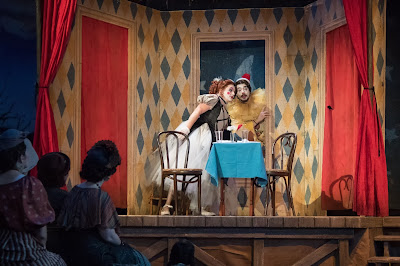Live performances are the most exhilarating and challenging photography opportunities for me. Unlike landscape photography, where the scene changes only minute-by-minute, event photography consists of scenes that change in an instant -- half a second too soon or too late and you miss the key moment.
Consequently, I look forward to photographing the dress rehearsals for the productions of our regional opera company, Opera Southwest, every spring and fall.
As I noted in my previous post, this spring's production was "Pagliacci." Singers of the principal roles included
Raul Melo as Canio . . .
Cammy Cook as Nedda, wife of Canio . . .
Carlos Archuleta as Tonio (in love with, but rejected by, Nedda) . . .
and Paul Bower as Silvio (Nedda's secret lover).
And the live orchestra featured the first woman conductor for an OSW production: Zoe Zeniodi.
To recap the plot . . .
It's a love triangle complicated by an extra player (love quadrangle?) who is both fool and manipulator. The husband (Canio), wife (Nedda), and fool (Tonio) are all members of a traveling troupe who perform a comedic play-within-the play about an unfaithful wife and clueless husband.
In the world outside the interior play, however, things aren't so funny. Nedda is in love with Silvio who wants her to elope with him.
Tonio is in love with Nedda . . .
but she rejects him and things get violent.
Tonio sees Nedda and Silvio together
and brings Canio to see for himself . . .
Silvio escapes; Canio confronts Nedda, who refuses to identify her lover, and threatens her with a knife.
But Tonio persuades Canio to relent, and convinces him that her lover will probably be in the audience and will give himself away during the performance of the comedy.
At the end of Act I, Canio sings the closing aria,"vesti la giubba" ("put on the costume"), as he puts on his makeup for the role of Pagliaccio (the clown), and the jealous, angry Tonio looks on.
The aria is regarded as one of the most moving in the operatic repertoire, exemplifying the "tragic clown" smiling on the outside but crying on the inside.
Put on the costume, the powder and the paint:
the people pay and want to laugh.
Change all your tears and anguish into clowning:
and into a grimace your sobbing and your pain...
Laugh, Pagliaccio, at your shattered love!
Laugh at the sorrow that has rent your heart!
- / - / - / - / - / - / -
The ultimate confrontation and resolution occurs in Act II via the play-within-the play which runs off the rails. Needless to say, things end badly.
The townspeople gather to watch the troupe perform the comedy, and Nedda (as Colombina in the play) passes the hat for donations while Tonio keeps an eye on her.
The play begins, and Nedda/Colombina tells the audience that her husband is out drinking, and she is waiting for a visit from her lover.
Shenanigans ensue, involving Colombina; Harlequin (her lover in the play); and Taddeo (real-life rejected suitor Tonio).

Taddeo bursts in to say that Pagliaccio, her husband, is on his way, and, in classic farce mode, everybody scrambles.
Eventually, Canio/Pagliaccio loses it, rips off his hat and collar, and breaks character, singing "No, Pagliaccio non son" ("No, I am not Pagliaccio").
They argue . . .
and Nedda/Colombina tries valiantly to pretend that this is all just part of the play . . .
but Canio/Pagliacci has had enough. He pulls a knife . . .
and the audience, including Silvio, knows something is terribly wrong . . .
Canio grabs Nedda and stabs her . . .
Silvio rushes to help her, but it's too late . . .
and Canio isn't done yet . . .
In this production, Tonio gets the last line: "La commedia è finita!"
Enjoy!























































